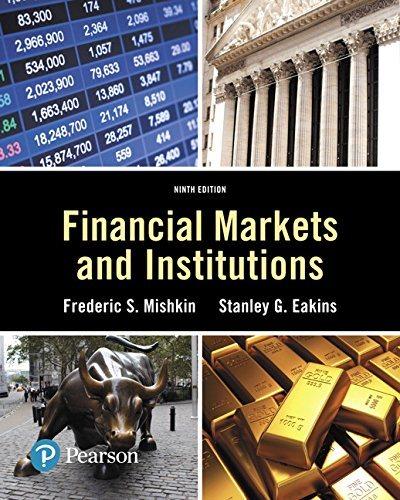Question
For each question, show the formula necessary to solve problem, and the formula with correct values from the question (even if you are using the
For each question, show the formula necessary to solve problem, and the formula with correct values from the
question (even if you are using the financial calculator).
If using the financial calculator, clearly show all calculator inputs.
Conclude each question with a concluding therefore statement.
Throughout the question, maintain at least 6 decimals, and in final answer, report 2 decimal places. Interest
rates should be expressed as a percentage.
Question 1:
Assume it is now January 1, 2000, and you are offered the following deal: starting from year 2000, you will be
receive each year the amount of dollars equal to the year, i.e., $2000, $2001, $2002, etc., until year 3000
inclusive. Payments occur at the year end and the interest rate remains at 10% throughout the life of the
investment, what is the most you would pay for this investment? How much would you pay for this deal if the
payments cover only the years from 2000 to 2050 inclusive? What can you conclude from the comparison?
Question 2: You plan to retire 24 years from now, and you expect that you will live 35 years after retiring. You want to
have enough money upon reaching retirement age to withdraw $175,000 from the account at the beginning
of each year you expect to live, and yet still have $1,000,000 left in the account at the time of your expected
death. You plan to accumulate the retirement fund by making equal bi-weekly deposits at the end of each two
week period for the next 24 years. You expect that you will be able to earn a quoted rate of 10%, compounded
semi-annually on your deposits. However, you only expect to earn an EAR of 5% on your investment after you
retire since you will choose to place the money in less risky investments. What equal bi-weekly deposits must
you make to reach your retirement goal?
Question 3:
You have just been granted a business loan of $1,000,000. The terms of the loan requires that you pay off the
loan in quarterly installments over a period of ten years. The bank is charging you an APR of 10%,
compounded monthly.
a) Calculate the interest payment and construct a complete amortization schedule that breaks down the
interest and principal repayment associated with each interest payment.
b) After five years, you put down a lump sum of $100,000 on the loan. You keep your payments the
same as in (a). By how much time have you shortened the life of your loan?
c) Using present value formulas you learned in class, show the interest and principal payment portions
of the 32nd payment, and reconcile your result with the amortization schedule constructed in (a).
Question 4: Rideau Auctions dividends are expected to grow at 25% during the next year and then 8% per year
indefinitely. The required return on this stock is 13%, and the stock currently sells for $85 per share. What is
the value of the dividend per share that Rideau Auctions just paid?
Question 5:
A bond of MacKinnons Inc. has face value of $1000, pays 6% coupon semiannually, and has 20 years to
maturity. The bond has a quoted price of 102.
a) What is the yield to maturity on MacKinnons bond?
b) What is the current yield?
c) By how many percentage points would the price of MacKinnons bond change if the market interest
rates suddenly increase by 1%?
d) What will the market price of this bond be one year from now if the required yield on similar bonds
falls to 2% in one year from now?
e) If you sell the bond in three and a half years from now at 102.7, what is your holding period yield?
Step by Step Solution
There are 3 Steps involved in it
Step: 1

Get Instant Access to Expert-Tailored Solutions
See step-by-step solutions with expert insights and AI powered tools for academic success
Step: 2

Step: 3

Ace Your Homework with AI
Get the answers you need in no time with our AI-driven, step-by-step assistance
Get Started


